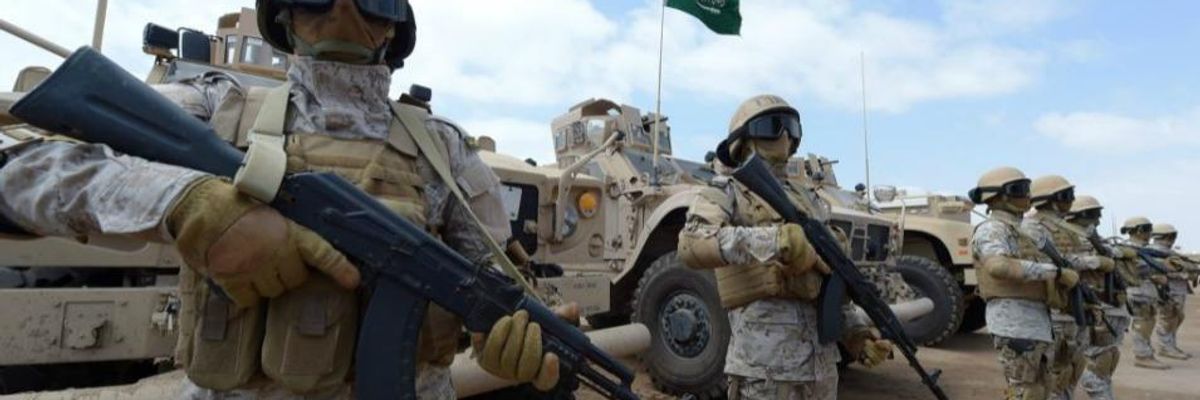
Saudi forces take part in military exercises during a visit by Yemeni Prime Minister Khaled Bahah at the Saudi-led coalition military base in Yemen's southern embattled city of Aden. (Photo: Ahmed Farwan/Flickr/cc)
Thanks to Deals Inked Under Obama, US Extends Lead in Global Arms Trade
Saudi Arabia is the second-largest weapons importer in the world, receiving many of its arms from the U.S. as it wages war in Yemen
Arms trade deals signed during the Obama administration have led to a rise in U.S. weapons exports in recent years, with nearly half of U.S. weapons going to the Middle East, fueling violent conflicts there.
New research completed by the Stockholm International Peace Research Institute (SIPRI) found that the global arms trade rose by about 10 percent from 2013 to 2017, during which the U.S. increased its sales by about 25 percent and accounted for about a third of global weapons exports.
The study was released as peace activists and some lawmakers have called for an end to U.S. arms sales to countries including Saudi Arabia. The Saudis, now the world's second-largest weapons importers, have led a military coalition against the Houthi rebels in Yemen since 2015 using weapons and intelligence from the Pentagon--giving way to a humanitarian crisis in the impoverished country and killing hundreds of civilians.
"Widespread violent conflict in the Middle East and concerns about human rights have led to political debate in western Europe and North America about restricting arms sales," Pieter Wezeman, senior researcher for SIPRI, told the Guardian. "Yet the U.S.A. and European states remain the main arms exporters to the region and supplied over 98 percent of weapons imported by Saudi Arabia."
The U.S. now sells 58 percent more weapons than Russia, the world's second-biggest arms exporter.
The Obama administration negotiated more arms contracts than any administration since World War II and loosened restrictions on sales of weapons, tanks, and military helicopters.
"These deals and further major contracts signed in 2017 will ensure that the USA remains the largest arms exporter in the coming years," Dr. Aude Fleurant, director of the SIPRI's arms and military expenditure program, told the Guardian.
An Urgent Message From Our Co-Founder
Dear Common Dreams reader, The U.S. is on a fast track to authoritarianism like nothing I've ever seen. Meanwhile, corporate news outlets are utterly capitulating to Trump, twisting their coverage to avoid drawing his ire while lining up to stuff cash in his pockets. That's why I believe that Common Dreams is doing the best and most consequential reporting that we've ever done. Our small but mighty team is a progressive reporting powerhouse, covering the news every day that the corporate media never will. Our mission has always been simple: To inform. To inspire. And to ignite change for the common good. Now here's the key piece that I want all our readers to understand: None of this would be possible without your financial support. That's not just some fundraising cliche. It's the absolute and literal truth. We don't accept corporate advertising and never will. We don't have a paywall because we don't think people should be blocked from critical news based on their ability to pay. Everything we do is funded by the donations of readers like you. Will you donate now to help power the nonprofit, independent reporting of Common Dreams? Thank you for being a vital member of our community. Together, we can keep independent journalism alive when it’s needed most. - Craig Brown, Co-founder |
Arms trade deals signed during the Obama administration have led to a rise in U.S. weapons exports in recent years, with nearly half of U.S. weapons going to the Middle East, fueling violent conflicts there.
New research completed by the Stockholm International Peace Research Institute (SIPRI) found that the global arms trade rose by about 10 percent from 2013 to 2017, during which the U.S. increased its sales by about 25 percent and accounted for about a third of global weapons exports.
The study was released as peace activists and some lawmakers have called for an end to U.S. arms sales to countries including Saudi Arabia. The Saudis, now the world's second-largest weapons importers, have led a military coalition against the Houthi rebels in Yemen since 2015 using weapons and intelligence from the Pentagon--giving way to a humanitarian crisis in the impoverished country and killing hundreds of civilians.
"Widespread violent conflict in the Middle East and concerns about human rights have led to political debate in western Europe and North America about restricting arms sales," Pieter Wezeman, senior researcher for SIPRI, told the Guardian. "Yet the U.S.A. and European states remain the main arms exporters to the region and supplied over 98 percent of weapons imported by Saudi Arabia."
The U.S. now sells 58 percent more weapons than Russia, the world's second-biggest arms exporter.
The Obama administration negotiated more arms contracts than any administration since World War II and loosened restrictions on sales of weapons, tanks, and military helicopters.
"These deals and further major contracts signed in 2017 will ensure that the USA remains the largest arms exporter in the coming years," Dr. Aude Fleurant, director of the SIPRI's arms and military expenditure program, told the Guardian.
Arms trade deals signed during the Obama administration have led to a rise in U.S. weapons exports in recent years, with nearly half of U.S. weapons going to the Middle East, fueling violent conflicts there.
New research completed by the Stockholm International Peace Research Institute (SIPRI) found that the global arms trade rose by about 10 percent from 2013 to 2017, during which the U.S. increased its sales by about 25 percent and accounted for about a third of global weapons exports.
The study was released as peace activists and some lawmakers have called for an end to U.S. arms sales to countries including Saudi Arabia. The Saudis, now the world's second-largest weapons importers, have led a military coalition against the Houthi rebels in Yemen since 2015 using weapons and intelligence from the Pentagon--giving way to a humanitarian crisis in the impoverished country and killing hundreds of civilians.
"Widespread violent conflict in the Middle East and concerns about human rights have led to political debate in western Europe and North America about restricting arms sales," Pieter Wezeman, senior researcher for SIPRI, told the Guardian. "Yet the U.S.A. and European states remain the main arms exporters to the region and supplied over 98 percent of weapons imported by Saudi Arabia."
The U.S. now sells 58 percent more weapons than Russia, the world's second-biggest arms exporter.
The Obama administration negotiated more arms contracts than any administration since World War II and loosened restrictions on sales of weapons, tanks, and military helicopters.
"These deals and further major contracts signed in 2017 will ensure that the USA remains the largest arms exporter in the coming years," Dr. Aude Fleurant, director of the SIPRI's arms and military expenditure program, told the Guardian.

